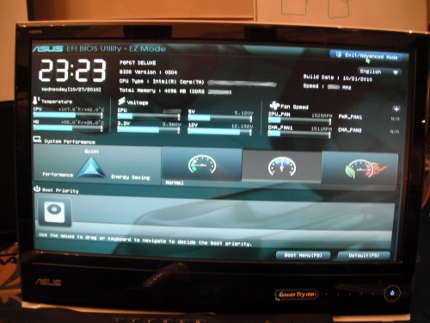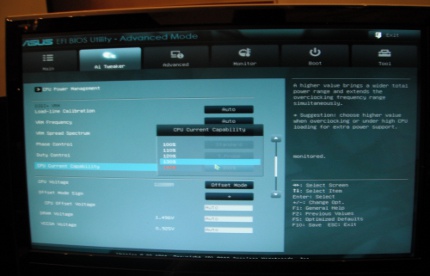Bye bye, BIOS
While this is all going on under the bonnet, a much more visible change will be the shift to EFI, which will be standard across all of ASUS's P67 boards. For those in need of a refresher, the Extensible Firmware Interface replaces the prehistoric system BIOS as the conduit between the OS and all of the hardware. Not only is EFI much faster, but it allows for a mouse driven GUI and bootable hard drives above 2.2TB.
The implementation that we saw on these boards was very smooth, and a refreshing change to the blue and grey screens that we're used to in BIOS. While there was an advanced mode that allowed you to get into the nitty-gritty, ASUS's EZ-Mode made tuning your PC for efficiency or performance a breeze. Also note the ability to select the boot-priority via 'drag-and-drop' in the bottom-left corner of the picture above.
The last mile
The last of the features was probably our favourite - though that might just be because we love it when gadgets get along. The Maximus IV Extreme and the P8P67 Deluxe both had integrated Bluetooth modules that allowed you to make adjustments to the system on the fly from an app installed on a smartphone. While it also lets you synchronise files and control media functions on the PC, the main use of the app was to perform 'last mile' tuning.
Through the app, it was possible to make changes to all of the normal BIOS settings - including voltages and clock speeds - while the computer was running, with changes taking effect in real time. In addition, the computer could be shutdown and rebooted remotely, and we're told that the ability to boot the PC when it's off will appear in the future. Best of all, because this was an almost completely hardware-based implementation, CPU utilisation was less than one per cent - a claim that the competition supposedly can't make.
A little something for the future
Of course, ASUS couldn't let us go without teasing one of its future products. Codenamed 'Thunderbolt', the new add-in card - which will presumably ship with some of the higher-end ROG mainboards - combines a soundcard with a dedicated network processor (NPU) that completely bypasses the Windows networking stack. The goal is to provide higher-quality audio courtesy of the inbuilt amp and lower latencies with the NPU in one card. Unfortunately we couldn't get any more details, but apparently we'll learn a lot more at CES in January.
ASUS may be a global leader in motherboard design and manufacturing, but rather than rest on its laurels, the company is clearly using its position to innovate and develop technologies that will ensure it remains on top. We left today's session impressed, and are looking forward to getting more hands-on time with the company's latest boards when they arrive on our test bench.















